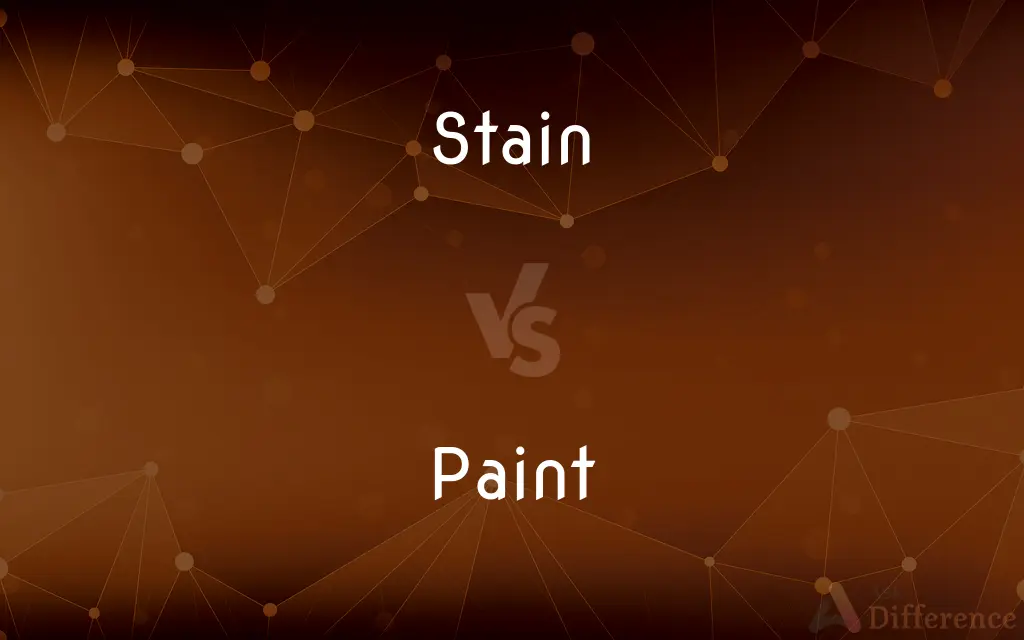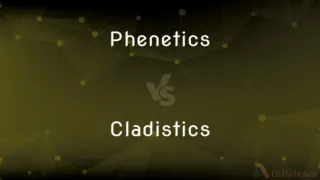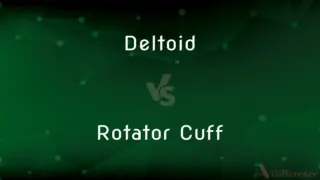Stain vs. Paint — What's the Difference?
By Tayyaba Rehman & Fiza Rafique — Published on February 25, 2024
Stain penetrates and highlights the surface's natural texture, while paint coats and colors the surface, often hiding its original appearance.

Difference Between Stain and Paint
Table of Contents
ADVERTISEMENT
Key Differences
Stain is designed to penetrate the surface it's applied to, enhancing the natural grain and texture of materials like wood. This characteristic allows the substrate's inherent beauty to come through, often used for its protective qualities and aesthetic appeal. In contrast, paint is formulated to create a solid, opaque layer on top of the surface, effectively covering the original material and providing a wide range of color options. This makes paint more versatile for decorative purposes.
The application process of stain and paint also differs significantly. Stain is usually wiped or brushed on and then wiped off to achieve the desired intensity, relying on absorption into the material. Paint, on the other hand, is typically applied in coats and left to dry, forming a protective layer that adheres to the surface.
Durability and maintenance requirements vary between stain and paint. Stained surfaces may need more frequent reapplication or maintenance, especially in high-traffic areas or when exposed to the elements, as the stain can fade or wear away. Painted surfaces, while potentially more durable, can chip or crack and may require touch-ups or a new coat to maintain their appearance.
The choice between stain and paint often comes down to the desired aesthetic and functional needs of the project. Stain is preferred for projects where the goal is to enhance and protect the natural beauty of the material, whereas paint is chosen for its ability to transform and protect a surface with color.
Environmental considerations also play a role in choosing between stain and paint. Stains generally have a lower volatile organic compound (VOC) content compared to traditional paints, making them a more eco-friendly option in some cases. However, advancements in paint technology have led to the development of low-VOC and zero-VOC paints, bridging the gap in environmental impact.
ADVERTISEMENT
Comparison Chart
Composition
Penetrative, often thinner
Coating, often thicker
Appearance
Enhances natural texture
Hides texture, solid color
Application
Absorbed into the surface
Forms a layer on the surface
Maintenance
May require more frequent upkeep
Generally more durable
Environmental
Often lower in VOCs
Higher VOCs, though low-VOC options available
Compare with Definitions
Stain
To color a material by applying a penetrating substance.
We decided to stain the deck to protect it from the weather.
Paint
A colored substance applied in a liquid form to a surface, drying to form a solid layer.
We chose a bright blue paint for the nursery walls.
Stain
A substance used to penetrate a surface and highlight its natural texture.
The carpenter applied a walnut stain to the oak table.
Paint
To create an image with this substance.
She loves to paint landscapes in her free time.
Stain
To bring into disrepute.
The scandal stained his reputation.
Paint
To coat with cosmetic makeup.
She painted her nails a bright red.
Stain
A discoloration or mark made on something.
The red wine left a stain on the carpet.
Paint
To apply this substance to a surface.
They plan to paint the fence white.
Stain
To become marked or discolored.
Be careful, or the juice will stain your shirt.
Paint
To describe vividly in words.
The author painted a vivid picture of life in the 18th century.
Stain
To discolor, soil, or spot.
The spilled juice stained the carpet.
Paint
The thin dry film formed by such a mixture when applied to a surface.
Stain
A liquid substance applied especially to wood that penetrates the surface and imparts a rich color.
Paint
To practice the art of painting; as, the artist paints well.
Stain
To bring into disrepute; taint or tarnish.
The scandal stained the mayor's reputation.
Paint
A liquid mixture, usually of a solid pigment in a liquid vehicle, used as a decorative or protective coating.
Stain
To coat a surface with a stain.
To stain wood with acids, coloured washes, paint rubbed in, etc.
The stained glass used for church windows
Paint
A cosmetic; rouge.
Paint
A substance used as a coating to protect or decorate a surface (especially a mixture of pigment suspended in a liquid); dries to form a hard coating.
Paint
To serve as a surface to be coated with paint.
These nonporous surfaces paint badly with a brush.
Common Curiosities
Can stain be used over paint?
Generally, stain is not effective over paint as it's designed to penetrate the surface, which paint prevents.
What's the main difference between stain and paint?
Stain penetrates and emphasizes the natural texture, while paint covers and colors the surface.
How long does stain last compared to paint?
Stain may require more frequent reapplication, while paint tends to last longer but might need touch-ups.
Can paint be applied over stain?
Yes, paint can be applied over stain, but proper surface preparation is crucial for adherence.
Is staining cheaper than painting?
Staining can be less expensive due to less material needed, but costs vary based on the project and materials.
Can I use stain on metal or plastic surfaces?
Stain is primarily for porous surfaces like wood and may not adhere well to non-porous surfaces like metal or plastic.
Is stain or paint better for outdoor use?
Both can be suitable for outdoor use, but the choice depends on the desired finish and maintenance commitment.
Is a primer needed for staining like with painting?
Primer is not usually required for staining as it's meant to penetrate the wood, not sit atop it.
Is it easier to apply stain or paint?
Stain application can be simpler but requires careful timing, while painting requires more preparation but is more forgiving.
Do stains come in different colors like paint?
Stains are available in various colors, but the range is typically more limited than paint.
Can I use interior paint or stain for exterior projects?
It's best to use products formulated for exterior use to ensure durability and resistance to weather conditions.
How does the environmental impact of stain compare to paint?
Stains typically have lower VOC content, making them more eco-friendly, though low-VOC paints are also available.
How do maintenance requirements differ between stained and painted surfaces?
Stained surfaces may need more frequent reapplication, while painted surfaces might require occasional touch-ups or a new coat for maintenance.
Can both stain and paint be used on the same project?
Yes, but they serve different purposes and should be used in appropriate areas according to the desired effect.
Are there special types of stain and paint for specific projects?
Yes, there are various types of stains and paints formulated for specific materials and applications, such as deck stain or exterior paint.
Share Your Discovery

Previous Comparison
Phenetics vs. Cladistics
Next Comparison
Deltoid vs. Rotator CuffAuthor Spotlight
Written by
Tayyaba RehmanTayyaba Rehman is a distinguished writer, currently serving as a primary contributor to askdifference.com. As a researcher in semantics and etymology, Tayyaba's passion for the complexity of languages and their distinctions has found a perfect home on the platform. Tayyaba delves into the intricacies of language, distinguishing between commonly confused words and phrases, thereby providing clarity for readers worldwide.
Co-written by
Fiza RafiqueFiza Rafique is a skilled content writer at AskDifference.com, where she meticulously refines and enhances written pieces. Drawing from her vast editorial expertise, Fiza ensures clarity, accuracy, and precision in every article. Passionate about language, she continually seeks to elevate the quality of content for readers worldwide.
















































